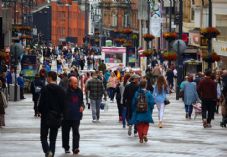UK DIY News
BRC-KPMG: Mixed Retail Performance In March

2020 was a turbulent year in which much of retail bounced between being open and closed, significantly impacting sales and the ability to make meaningful comparisons. In this context, all 2021 figures are compared with 2019 (pre-pandemic). This means our 2021 figures are now year-on-two-years (Yo2Y), rather than year-on-year (YoY).
Covering the five weeks 28 February – 3 April 2021
- While total sales show growth, out of the 13 categories tracked, 8 remained in significant decline. The pandemic has concentrated spend on home centric categories such as food, computing and home appliances. While others, such as fashion and beauty remain in double digit decline compared to pre-pandemic levels.
- On a Total basis, sales increased by 8.3 percent in March compared to the same period in 2019, against a decline of 0.5 percent in March 2019. This is above the 3-month average growth of 2.7 percent.
- UK retail sales increased 8.4 percent on a Like-for-like basis from March 2019, when they had decreased 1.1 percent from the preceding year.
- Over the three months to March on a 2-year basis, In-Store sales of Non-Food items declined 44.4 percent on a Total and 44.0 percent on a Like-for-like basis. This is worse than the 2019 Total average decline of 3.1 percent. For March, the 2-year like-for-like excluding temporarily closed stores remained in decline.
- Over the three months to March over two years, Food sales increased 14.7 percent on a Like-for-like basis and 11.6 percent on a Total basis. This is higher than the 2019 Total average growth of 1.4 percent. For the month of March, Food was in growth year-on-year.
- Over the three-months to March over two years, Non-Food retail sales decreased by 4.5 percent on a like-for-like basis and 4.7 percent on a Total basis. This is below the 2019 Total average decline of 1.3 percent. For the month of March, Non-Food was in growth year-on-year.
- Online Non-Food sales increased by 94.0 percent in March on a 2-year basis, against a growth of 3.0 percent in March 2019. This is above the 3-mth average of 90.8 percent.
- Non-Food Online penetration rate increased from 43.3 percent in March 2020 to 58.0 percent this March.
Helen Dickinson OBE, Chief Executive | British Retail Consortium
“As we pass the one-year anniversary of the first lockdown, the retail industry has generally remained strong, despite numerous challenges. 2020 was a year like no other, with panic buying followed by a sharp decline in consumer spend, and then the first national lockdown which resulted in erratic retail sales. This makes a direct comparison challenging, so for a truer indication of where the industry stands, we changed our year-on-year comparisons for a two-year, pre-pandemic comparison period. March 2021 saw an 8.3 percent increase in spending compared to March 2019, which was largely driven by grocery spending. However, the majority of categories remain in decline, and fashion and footwear remain the hardest hit. Meanwhile, with many stores still closed, online purchases reached the highest on record, particularly for TVs, gaming consoles and laptops.
“Despite some product ranges trading well, the next six months will be make or break for many retailers. Over the past three lockdowns, non-food retail stores have lost £30 billion, so many retailers will be relying on growing consumer confidence, and a return to town and city centres to fuel their recovery. Retail businesses have spent hundreds of millions making their stores Covid-secure, so customers can feel safe and confident whilst shopping. We remind people to be considerate and respectful of other shoppers and hard-working retail staff so we can all safely enjoy our nation’s return to its stores.”
Paul Martin, UK Head of Retail | KPMG
“One year on from our first national lockdown the retail sector has changed dramatically, but remains remarkably resilient. March last year was a real anomaly and unlike anything we have seen before, with queues of consumers panic buying items and images of empty shelves across our media. Whilst a direct comparison of March 2021 with the previous year is therefore difficult, comparing retail sales of March 2021 to March 2019 reveals total sales have grown by 8.3 percent, despite the challenges of the last 12 months. In that context last month saw historic growth rates in online sales, with some categories like Men’s and Children’s clothing and Furniture reaching triple digits. This is testament to how retailers, many of which have spent much of the last year with their doors closed, have embraced trading through lockdown via digital platforms.
“As we enter the next stage of the Government’s roadmap to recovery this month, high streets across the country will be hoping that pent up demand from consumers will be released and cash registers will start to ring again. Government support packages will provide some relief to struggling retailers until after the summer, but conditions will continue to be incredibly challenging as they face thinner margins and rising costs. All hopes of a strong recovery now rest on consumers feeling more confident to move away from their homes and hitting the high street to browse the stores that have been out of bounds for months.”
Susan Barratt, CEO | IGD
“Food and grocery showed a more restrained performance in March, following a strong February and nearly 12 months of elevated performance through the pandemic. However, March was still not a return to what we would usually expect for the time of year, as it was further distorted by the changed timing of Easter. Additionally, trading conditions have still been affected by the ongoing closure of non-essential retail and the out-of-home sector. We are unlikely to see a more settled, post-pandemic food and grocery performance until after restrictions further ease through April and May.
“IGD’s Shopper Confidence Index remained at its highest level since January 2020. Confidence improved towards the end of March as lockdown began to lift and the focus turned to outdoor family gatherings over Easter. While shopper sentiment is likely to improve as the economy opens up from April, confidence is likely to remain polarised, with confidence elevated among higher affluence groups but remaining fragile among lower affluence groups.”
Source : BRC-KPMG
Thank you for the excellent presentation that you gave at Woodbury Park on Thursday morning. It was very interesting and thought-provoking for our Retail members. The feedback has been excellent.











































